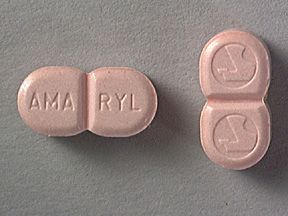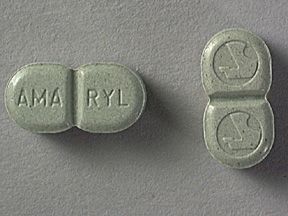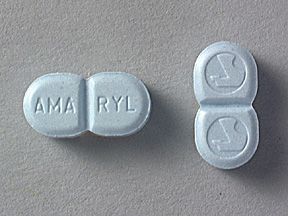Amaryl (glimepiride) is a prescription drug that’s used to treat type 2 diabetes. The drug comes as a tablet that you swallow. It’s usually taken once per day.
Amaryl is used in adults to treat type 2 diabetes. It’s prescribed along with exercise and a balanced diet to help manage blood sugar levels.
The active ingredient in Amaryl is glimepiride. (An active ingredient is what makes a drug work.) Amaryl belongs to a group of drugs called sulfonylureas.
This article describes the dosage and administration of Amaryl. To learn more about Amaryl, see this in-depth article.
The chart below highlights the basics of Amaryl’s dosage. Be sure to read on for more details.
| Recommended starting dosage | Maximum dosage |
| 1 or 2 milligrams (mg) once per day | 8 mg once per day |
What is Amaryl’s form?
Amaryl comes as a tablet that you swallow.
What strengths does Amaryl come in?
Amaryl tablets come in the following strengths:
- 1 milligram (mg)
- 2 mg
- 4 mg
What are the usual dosages of Amaryl?
Your doctor will usually start you on a low dose of Amaryl. Then they’ll adjust it over time to reach the right amount for you. They’ll ultimately prescribe the smallest dosage that best manages your blood sugar.
The information below describes Amaryl dosages for diabetes that are commonly used or recommended. But be sure to take the dosage your doctor prescribes for you. They’ll determine the best dosage to fit your needs.
The recommended starting dosage of Amaryl is 1–2 mg taken once daily. Your doctor will decide which starting dosage is safe for you based on your age and how well your kidneys work.
Your doctor will likely test your blood sugar level periodically to check how well Amaryl is working. If this medication is not lowering your blood sugar enough, they’ll increase your dose by 1–2 mg at a time. They’ll do this every few weeks until you reach a dose that works for you.
The maximum dosage of Amaryl is 8 mg per day.
Is Amaryl taken long term?
Yes, Amaryl is typically used as a long-term treatment. If you and your doctor determine that Amaryl is safe and effective for you, you’ll likely take it long term.
Dosage adjustments
Certain drugs can affect how well Amaryl works. It’s important to let your doctor know all the medications you take. They may need to adjust your Amaryl dose based on this information.
Depending on your age and how well your kidneys work, your doctor may decrease your Amaryl dose to reduce your risk of side effects from this drug.
The dosage of Amaryl you’re prescribed will depend on several factors. These include:
- the severity of the condition you’re using Amaryl to treat
- your age
- how well your kidneys are working
- other drugs you take
- other conditions you may have (see “Dosage adjustments” directly above)
Amaryl comes as a tablet that you swallow. It’s recommended that you take it once daily with breakfast or your first meal of the day.
For information on Amaryl expiration, storage, and disposal, see this article.
Accessible drug containers and labels
If you find it hard to read the prescription label on your medication, tell your doctor or pharmacist. Some pharmacies provide medication labels that:
- have large print or use braille
- feature a code that you can scan with a smartphone to change the text to audio
Your doctor or pharmacist may be able to recommend pharmacies that offer these accessibility features if your current pharmacy doesn’t.
If you have trouble opening medication bottles, let your pharmacist know. They may be able to supply Amaryl in an easy-open container. They may also have tips to make it simpler to open the drug’s container.
If you miss a dose of Amaryl, take it as soon as you remember. If it’s almost time for your next dose, just skip the missed dose and take your next dose at the regular time.
If you need help remembering to take your dose on time, try using a medication reminder. This can include setting an alarm or downloading a reminder app on your phone.
Do not take more Amaryl than your doctor prescribes. Taking more than this can lead to serious side effects, including severe hypoglycemia (low blood sugar).
Symptoms of overdose
Symptoms of Amaryl overdose are like the symptoms of very low blood sugar. These include:
What to do in case you take too much Amaryl
Call your doctor right away if you think you’ve taken too much Amaryl. You can also call 800-222-1222 to reach America’s Poison Centers or use its online resource. But if you have severe symptoms, call 911 (or your local emergency number) immediately or go to the nearest emergency room.
The sections above describe the usual dosages provided by the drug’s manufacturer. If your doctor recommends Amaryl for you, they’ll prescribe the dosage that’s right for you.
Remember, you should not change your dosage of Amaryl without your doctor’s recommendation. Only take Amaryl exactly as prescribed. Talk with your doctor if you have questions or concerns about your current dosage. Here are some examples of questions you may want to ask your doctor:
- Will my dose of Amaryl be different if I’m age 65 years or older?
- Will my Amaryl dose be affected if I’m taking insulin along with it?
- Would a lower dose of Amaryl reduce my risk of side effects?
To learn more about Amaryl, see these articles:
To get information on different conditions and tips for improving your health, subscribe to any of Healthline’s newsletters. You may also want to check out the online communities at Bezzy. It’s a place where people with certain conditions can find support and connect with others.
Q:
Will my doctor need to change my Amaryl dosage if I start taking a steroid medication?
AnonymousA:
It depends. Corticosteroids, such as prednisone (Rayos) and methylprednisolone (Medrol), can make Amaryl less effective. They can also increase your blood sugar for part of the day.
If you’re only taking corticosteroids for a short time, your doctor may not need to adjust your Amaryl dose. But they’ll likely have you check your blood sugar often while taking the steroid and after you stop taking it. They’ll let you know if you should change your Amaryl dosage based on your blood sugar levels.
If you’re taking a corticosteroid long term, your doctor may need to adjust your Amaryl dose if your blood sugar levels are too high.
It’s important to tell your doctor and pharmacist about all the medications you take as well as any you stop taking.
To learn more about Amaryl dosage adjustments specific to your type 2 diabetes treatment, talk with your doctor.
The Healthline Pharmacist TeamAnswers represent the opinions of our medical experts. All content is strictly informational and should not be considered medical advice.Disclaimer: Healthline has made every effort to make certain that all information is factually correct, comprehensive, and up to date. However, this article should not be used as a substitute for the knowledge and expertise of a licensed healthcare professional. You should always consult your doctor or another healthcare professional before taking any medication. The drug information contained herein is subject to change and is not intended to cover all possible uses, directions, precautions, warnings, drug interactions, allergic reactions, or adverse effects. The absence of warnings or other information for a given drug does not indicate that the drug or drug combination is safe, effective, or appropriate for all patients or all specific uses.



